Vietnamese cuisine, a vibrant tapestry woven from history, culture, and the soul of the Vietnamese people, holds an irresistible allure for anyone who sets foot in this land. More than just delicious food, Vietnamese cuisine is a bridge that takes us back in time, exploring traditional values and unique cultural identities. And there’s no better way to fully experience this than by joining a traditional Vietnamese food tour.
If you are a lover of exploration, eager to delve deeply into Vietnamese culture through its food, or simply a food enthusiast wanting to satisfy your taste buds with distinctive flavors, then a traditional Vietnamese food tour is the perfect choice. This is not just a trip to enjoy food, but also a journey to discover the stories hidden behind each ingredient, cooking method, and the customs passed down through generations. Let “Du lịch khắp thế gian” guide you into this enchanting world of cuisine, where the flavors of home will lead you to unforgettable experiences.
Explore the Essence of Vietnamese Cuisine Through a Unique Tour
A traditional Vietnamese food tour is more than just tasting delicious dishes; it’s a profound cultural journey that brings you closer to the heart of Vietnam and its people. Unlike ordinary tours, a food tour focuses on exploring cuisine as a means to understand the history, geography, and customs of each region.
By joining a food tour, you will have the opportunity to:
- Savor local specialties: Beyond popular dishes, a food tour will take you to family-run eateries and local markets where you can taste unique specialties, prepared using traditional recipes and the freshest ingredients.
- Learn about culinary culture: You will hear fascinating stories about the origins and cultural significance of each dish, how they are prepared and enjoyed in daily life, as well as during traditional festivals.
- Meet and interact with locals: Food tours often include activities that involve interacting with local people, such as participating in cooking classes, visiting families with traditional crafts, or going to the market with locals. This allows you to gain a deeper understanding of their lives and food culture.
- Experience unique culinary spaces: From bustling street food stalls and vibrant food markets to ancient restaurants with historical charm, a food tour will offer you diverse and colorful culinary experiences.
A traditional Vietnamese food tour is a harmonious blend of culinary exploration and cultural tourism, offering you a fresh and profound perspective on the beautiful country of Vietnam.
Must-Try Dishes on a Traditional Vietnamese Food Tour
To make your culinary journey in Vietnam even more complete, here are some dishes that you cannot miss on a traditional Vietnamese food tour:
Banh Mi – An Icon of Vietnamese Street Food
Vietnamese Banh Mi, a renowned street food, is not just a convenient snack but also a unique cultural icon of Vietnamese cuisine. Born in the early 19th century, Banh Mi is a delicate fusion of French bread-making techniques and Vietnamese culinary flavors, creating a uniquely “hybrid” dish.
The special feature of Vietnamese Banh Mi lies in its crispy crust, soft and airy interior, and diverse, flavorful fillings. From traditional cold-cut Banh Mi with pate, Vietnamese sausage, cucumber, pickled vegetables, herbs, and savory sauce, to Banh Mi with fried eggs, Banh Mi with pork meatballs, and Banh Mi with shredded chicken, each type of Banh Mi offers a different taste experience.
Banh Mi has won the hearts of food lovers worldwide and has been praised by many reputable newspapers and travel websites. The Guardian, National Geographic, BBC, Tripadvisor, Fodor’s Travel… have all given rave reviews to this street food. In fact, Fodor’s Travel even honored Banh Mi as the world’s best street food in 2016.
On a traditional Vietnamese food tour, enjoying Banh Mi is not just eating a dish, but also experiencing a vibrant street culture and feeling the bustling rhythm of Vietnamese life. You can easily find Banh Mi anywhere on the streets of Vietnam, from small roadside carts to famous long-standing Banh Mi shops.
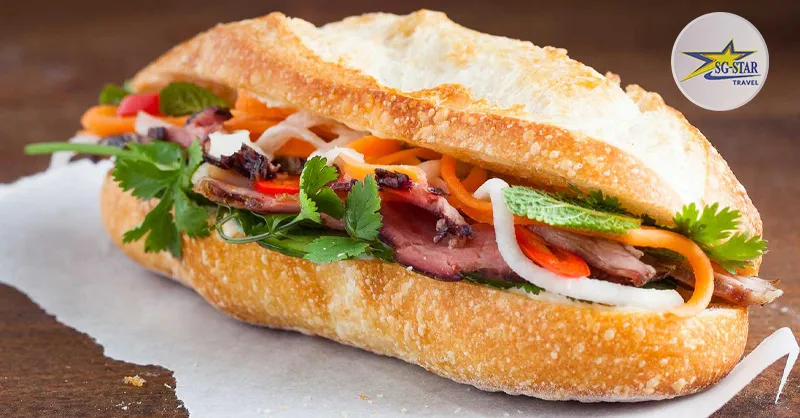
Pho – The “National Soul” of Vietnamese Cuisine
When mentioning traditional Vietnamese cuisine, Pho, the dish dubbed the “national soul,” a source of pride for the Vietnamese people, cannot be overlooked. Originating from Hanoi and Nam Dinh, Pho has become a popular dish throughout the country and is loved worldwide.
Pho is a delicate combination of soft rice noodles, rich broth simmered from beef bones for hours, thinly sliced tender beef, along with herbs, scallions, lime, and fresh chili. The distinctive flavor of Pho comes from the clear, sweet broth, rich in beef bone flavor, combined with the natural sweetness of beef and the aroma of spices.
Today, Pho has many variations such as chicken Pho, rolled Pho, and stir-fried Pho, but traditional beef Pho still holds an important place in the hearts of food lovers. To enjoy the authentic taste of beef Pho, you should visit Hanoi, considered the cradle of traditional beef Pho.
On a traditional Vietnamese food tour, enjoying a hot bowl of Pho in the early morning or a cool evening is a wonderful experience. You will feel the sophistication and meticulousness in the preparation and the delicious, rich flavor of this dish. Pho is not just food, but also a part of Vietnamese culture and history.
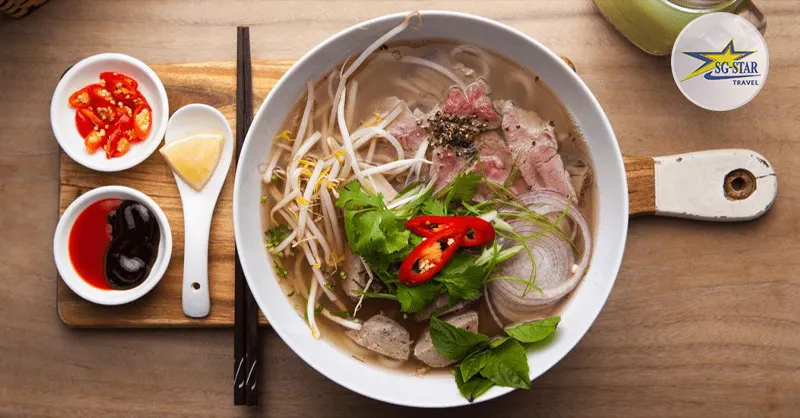
Banh Xeo – Crispy and Distinctive Regional Flavors
Banh Xeo is a rustic, familiar dish of the Vietnamese people, especially popular in the Central and Southern regions. Banh Xeo is made from rice flour, coconut milk, turmeric powder, filled with shrimp, meat, bean sprouts, onions, and fried crispy on a hot pan.
Banh Xeo has many variations depending on the region. Central Vietnamese Banh Xeo is usually small, thick, and crispy, while Southern Vietnamese Banh Xeo is often large, thin, and crispy-airy. Banh Xeo fillings are also diverse, including shrimp, meat, pork belly, mushrooms, jicama, etc.
To enjoy the best Banh Xeo, a crucial element is the sweet and sour dipping sauce skillfully made from fish sauce, sugar, lemon, chili, garlic, and pickled vegetables. Banh Xeo is often served with fresh raw vegetables such as lettuce, fish mint, perilla, basil, etc.
Banh Xeo is not only a delicious dish but also a distinctive part of Vietnamese culinary culture. This dish has been voted by CNN as one of the most popular street foods in the world.
On a traditional Vietnamese food tour, you will have the opportunity to enjoy Banh Xeo in many different regions, exploring the diversity and uniqueness of this dish. You can visit famous long-standing Banh Xeo shops or participate in Banh Xeo cooking classes to prepare this appealing dish yourself.
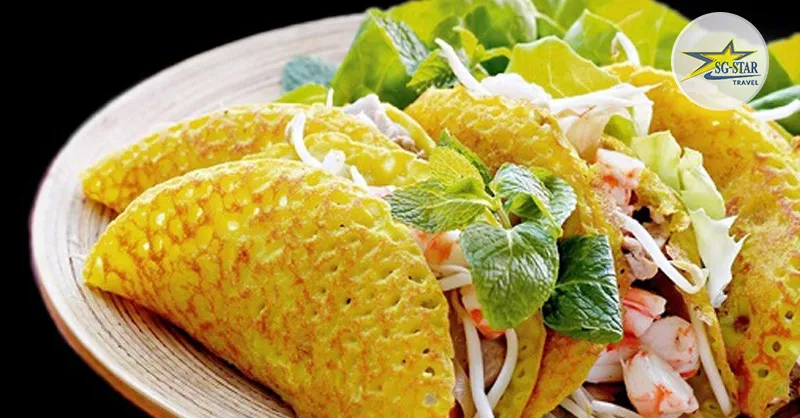
Banh Chung/ Banh Tet – Culinary Essence of Tet Holiday
Banh Chung and Banh Tet are two indispensable cakes in the tray of offerings during the traditional Tet holiday of Vietnamese people. Banh Chung, square-shaped, symbolizes the earth, and Banh Tet, cylindrical, symbolizes the sky, reflecting the concept of the universe and the wish for a peaceful and prosperous new year.
Banh Chung and Banh Tet are made from sticky rice, green beans, pork, wrapped in dong leaves or banana leaves, and boiled for many hours. Banh Chung is usually wrapped in a square shape, while Banh Tet is cylindrical. The filling can be green beans, fatty pork, or vegetarian.
Banh Chung and Banh Tet are not only delicious dishes but also carry deep cultural meaning. These cakes express gratitude to ancestors, pray for a prosperous new year, and are an occasion for family reunion and gathering.
On a traditional Vietnamese food tour, especially near Tet, you will have the opportunity to learn about the traditional process of making Banh Chung and Banh Tet, participate in wrapping cakes with locals, and enjoy the special flavor of these cakes. Banh Chung and Banh Tet are not just food, but also symbols of Vietnamese culture and tradition.
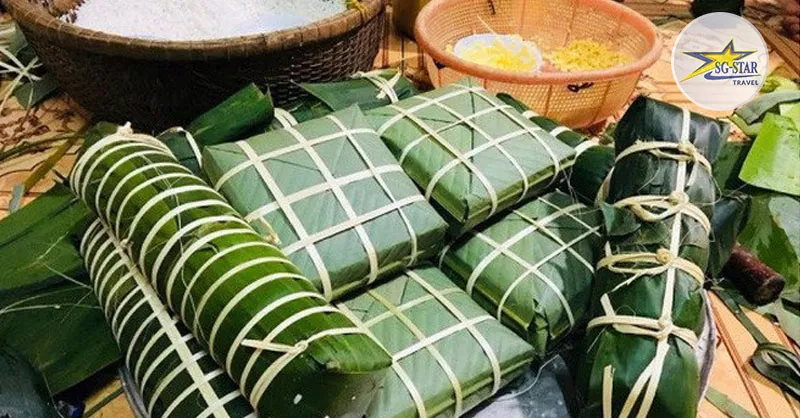
Nem Ran/ Cha Gio – Traditional Savory Appetizer
Nem Ran or Cha Gio (spring rolls) is a traditional appetizer, indispensable in Vietnamese feasts, Tet holidays, and ancestral anniversaries. Today, Nem Ran has become a familiar dish in the daily meals of many Vietnamese families.
Nem Ran is made from minced pork, shrimp, vermicelli, wood ear mushrooms, shiitake mushrooms, carrots, onions, eggs, and spices, wrapped in rice paper and deep-fried until crispy. Nem Ran has a delicious, rich, and crispy taste, and is usually served with sweet and sour dipping sauce and raw vegetables.
Nem Ran is a dish loved by both Vietnamese people and international visitors. This dish is not only delicious but also demonstrates the skill and sophistication in Vietnamese cuisine.
On a traditional Vietnamese food tour, you will have the opportunity to enjoy Nem Ran in many different restaurants and eateries, exploring the diversity in the preparation and flavor of this dish. You can also participate in cooking classes to make delicious Nem Ran yourself.
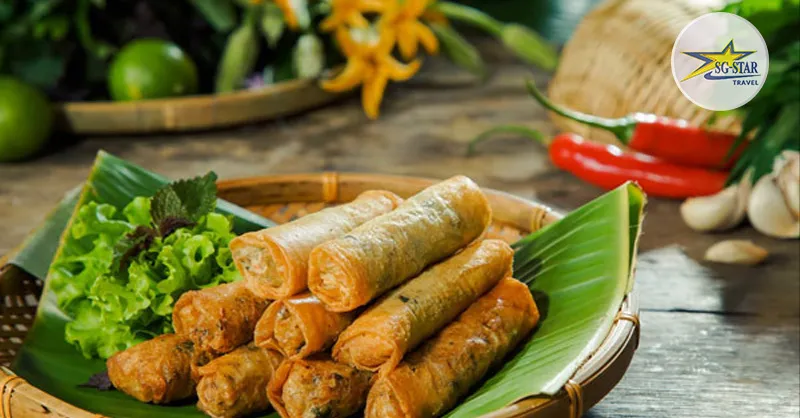
Goi Cuon – Light and Delicate Dish
Goi Cuon or Nem Cuon (fresh spring rolls) is a light, refreshing dish, very popular in Vietnam, especially in the South. Goi Cuon is made from rice paper wrapped around ingredients such as vermicelli, boiled shrimp, boiled pork, raw vegetables, bean sprouts, chives, etc. Goi Cuon is not fried, making it very healthy.
Goi Cuon has a light, refreshing flavor, and is usually served with dipping sauce or fermented fish sauce. This dish is perfect for enjoying on hot summer days.
Goi Cuon has contributed to Vietnamese cuisine setting a Guinness record for “The country with the most unique rolls in the world.” This dish has also been voted by CNN as one of the 50 most delicious dishes in the world.
On a traditional Vietnamese food tour, Goi Cuon is an indispensable dish for you to experience the lightness and delicacy of Vietnamese cuisine. You can enjoy Goi Cuon at many eateries and restaurants, or participate in Goi Cuon making classes to prepare this dish yourself.

Conclusion
A traditional Vietnamese food tour is not just a journey to discover flavors, but also an opportunity for you to understand more deeply about Vietnamese culture, history, and people. From rustic street food to elaborate royal dishes, Vietnamese cuisine always hides fascinating stories and unique cultural values.
Let a traditional Vietnamese food tour guide you through small streets, bustling markets, and traditional craft villages, so you can enjoy the most delicious dishes, meet the friendliest people, and fully feel the beauty of Vietnamese cuisine and culture. Surely, this journey will leave you with unforgettable memories and a deep love for the country and people of Vietnam.